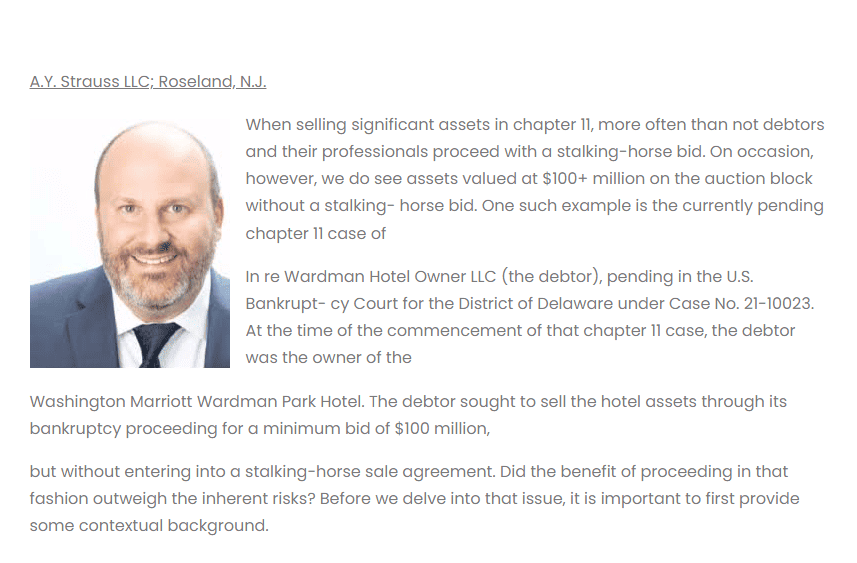January 11th, 2021, by Eric H. Horn
A.Y. Strauss LLC; Roseland, N.J.
When selling significant assets in chapter 11, more often than not debtors and their professionals proceed with a stalking-horse bid. On occasion, however, we do see assets valued at $100+ million on the auction block without a stalking- horse bid. One such example is the currently pending chapter 11 case of In re Wardman Hotel Owner LLC (the debtor), pending in the U.S. Bankrupt- cy Court for the District of Delaware under Case No. 21-10023. At the time of the commencement of that chapter 11 case, the debtor was the owner of the Washington Marriott Wardman Park Hotel. The debtor sought to sell the hotel assets through its bankruptcy proceeding for a minimum bid of $100 million, but without entering into a stalking-horse sale agreement. Did the benefit of proceeding in that fashion outweigh the inherent risks? Before we delve into that issue, it is important to first provide some contextual background.
On Jan. 11, 2021, the debtor filed a chapter 11 petition. At the time of the filing, the debtor was the sole owner of real property located in Woodley Park, Washington, D.C., formerly known as the Washington Marriott Wardman Park Hotel, a convention hotel — and Greater Washington’s third-largest hotel by room count.
During the past 20 or so years, the hotel changed hands a few times, with one purchase price nearing
$300 million. At the time of filing, PL Wardman Member, LLC, a wholly owned subsidiary of Pacific Life, owned the debtor. Pacific Life is also the debtor’s senior secured lender — with a term loan of
$122.5 million (approximately $130 million at the time of the filing).
According to first-day pleadings filed in the case, the stated goal at the time of filing was to liquidate the debtor’s assets — the most substantial of which was the hotel. In order to achieve that goal, the debtor retained Eastdil Secured, LLC as its real estate broker. Based on reporting in local DC journals, nearly 175 prospective buyers signed confidentiality agreements to receive more information, 31 toured the property, and 13 submitted formal expressions of interest.
The debtor also filed papers to implement certain bidding procedures to govern the sale process. Per the order entered by the bankruptcy court on June 15, a minimum bid of $100 million was required to be a qualified bidder. Additionally, a bid deadline of July 8 and a July 13 deadline to select a stalking- horse bidder were established. Notably, should the debtor select a stalking-horse bidder and such bidder is outbid at auction, the stalking horse would be entitled to a breakup fee and/or expense reimbursement in an amount not to exceed $3 million. Also, should the debtor choose a stalking horse, bids must exceed the stalking-horse bid by an amount of up to $3.25 million.
Ultimately, according to the debtor’s filed disclosure statement, three bids were received, two of which were deemed qualified bids under the terms of the bidding procedures previously approved by the bankruptcy court. The lead bid submitted at the start of the auction was in the amount of $120 million. The auction resulted in 130 rounds of bidding where, at the conclusion, Carmel Partners Realty VII, LLC was declared the successful bidder with a purchase price of $152.25 million.
Now, back to the original question: Did the benefit of proceeding without a stalking horse outweigh the inherent risk? To answer that question, I had the opportunity to sit down with Greg Corbin, the president of Bankruptcy and Restructuring at Rosewood Realty Group, who said the following:
In determining whether or not to use a stalking horse in a chapter 11 auction, there are a number of contributing factors, and each deal is case-specific. If given a choice, I always prefer to put a stalking horse in place versus conducting a na- ked auction — particularly for niche asset classes such as a hotel or where the assets exceed $100 million. It sets a floor, establishes the market, and takes the uncertainty out of the equation. The more people who show up and bid at auction the better, but if the stalking horse bid is exceptional, every additional bid can be viewed
as gravy. Setting a minimum threshold by way of stalking horse offers downside protection and has the additional benefit of sending a message to the market that
if one person is willing to pay the opening bid, it must be worth at least that number, if not more. It sets the bar psychologically. The only downside is that most stalking horse bidders will ask for bid protection and require a breakup fee, which is money that could have gone to the estate in the event of additional higher bids.
So while risky in general, it appears that in this case, it made sense not to put in place a stalking-horse bid. This is evidenced by the fact that only two bidders turned out to be qualified bidders under the bidding procedures. If one of those bidders had been chosen as the stalking horse, such bidder would have undoubtedly required certain bidding protections in the form of a break-up fee and/or expense reimbursement. Indeed, the debtor had authority to offer up to $3 million in bidding protections to a stalking-horse bidder. The fact that the bidding price would have to be increased by that amount, coupled with the fact that there were limited bids (two), could have chilled the auction and the extensive bidding that ultimately occurred. As it turned out, there were 130 rounds of bidding at the auction between the two qualified bidders, and the highest bid was $152.25 million — which was sufficient to fully satisfy the senior lending facility.
Again, as Greg Corbin noted, each deal is case-specific. Determining whether to put a stalking horse in place should be based on all of the facts of the particular bankruptcy, the debtor’s business and the type of assets that are being sold. In this case, based on the facts surrounding this asset sale, it not only made sense to proceed without a stalking-horse bid, it also benefited the bankruptcy estate
without having to incur a $3 million break-up fee —despite the inherent risks of holding an auction in a bankruptcy without a stalking-horse bidder.
[1] Eric H. Horn is a partner in the Financial Restructuring and Bankruptcy practice of A.Y. Strauss LLC.











